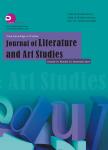
T=题名(书名、题名),A=作者(责任者),K=主题词,P=出版物名称,PU=出版社名称,O=机构(作者单位、学位授予单位、专利申请人),L=中图分类号,C=学科分类号,U=全部字段,Y=年(出版发行年、学位年度、标准发布年)
AND代表“并且”;OR代表“或者”;NOT代表“不包含”;(注意必须大写,运算符两边需空一格)
范例一:(K=图书馆学 OR K=情报学) AND A=范并思 AND Y=1982-2016
范例二:P=计算机应用与软件 AND (U=C++ OR U=Basic) NOT K=Visual AND Y=2011-2016

摘要:Poetic metaphor is a kind of conceptual structure formed by conceptual *** is the cognitive means,which is used by the poets to understand things and express *** a conceptual structure,the poetic metaphor expresses certain semantic content,and its meaning construction is a kind of non-linear integration *** the translation of poetic metaphor,the translators should take the conceptual integration theory as the guide,construe the poetic metaphor firstly,in order to understand that what entities are participated in the conceptual integration of the poetic metaphor,and how the process of conceptual integration is;then,take the construal results as the basis,and take the cultural background of the target language as a reference,to reconstruct poetic metaphor in the target language,so as to achieve the purpose of translation and information *** the process of poetic metaphor translation,the translator’s cognitive model,ability and preference,the proficiency of the source language and target language,the familiarity of the culture of the source language and target language,personal encyclopedic knowledge reserve,and personal language expressing preference will affect the translation results of poetic *** addition,when the translators reconstruct the poetic metaphor in the target language,they must follow the principle of semantic consistency,cultural adaptation and universality.
地址:宁波市钱湖南路8号浙江万里学院(315100)
Tel:0574-88222222
招生:0574-88222065 88222066
Email:yzb@zwu.edu.cn

